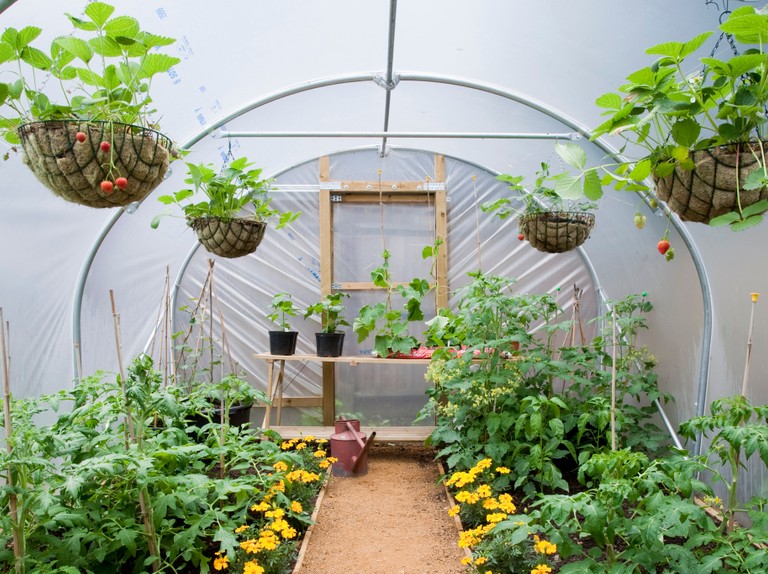Victorian greenhouses, sometimes referred to as glass greenhouses, are tasteful, alluring, and classic buildings. These glass greenhouses are sometimes referred to as the iconic greenhouse because of how transparent the glass is and how the surrounding lush vegetation gives the appearance that you are outside even though you are inside.
This will likely be enough rationale for most people to choose glass over polycarbonate or polyethylene film as their greenhouse covering material.
The glass greenhouse is a fantastic greenhouse investment since it gradually raises a person’s home’s and property’s worth. This is true since glass greenhouses often have stronger structures than other types of greenhouses due to the weight of the glass covering.
To improve insulation and ventilation, lower energy use, and better protect crops, Glass Greenhouses provide single, double, or triple-paned glass options. Compared to plastic, glass is far more inert. Its lifetime without failure is 40 to 50 years. It is non-combustible, preserves its original transmission, and is resistant to UV radiation and air pollution damage if properly maintained.
Reasons Why You Should You Purchase A Victorian Greenhouse
Purchasing a Victorian-style greenhouse has a number of benefits. Here is a concise rundown of the major reasons why you should get one.
- The material is durable.
A large Victorian greenhouse is a good investment for your yard. These constructions are sturdy and provide a garden room that seems to be a straightforward extension to your home’s living space.
- It provides efficient heat absorption.
The greenhouse’s vast glass surface area makes it simple for the sun’s heat to enter but challenging for it to exit. With this layout, you may grow more exotic plants like orchids or common greenhouse crops like tomatoes.
- The architecture maintains a consistent temperature.
Everything within the Victorian glasshouse is not as warm as it might be due to the construction of the building. Instead, the internal layout of Victorian Greenhouses enables you to regulate the temperature by simply opening the windows and vents, with the hot air rising to the high-peaking roof.
- It focuses on regulated humidity.
Your potted plants and trays will drain effectively if you distribute your plants equally around the inside of the Victorian Greenhouse and utilize windows, vents, and doors to manage humidity.
What to Think About When Purchasing a Victorian Greenhouse
The options are rather basic if you want a solarium, which is a sunroom that is attached to your home where you can relax and grow a few plants. This is because the materials required are ones that most builders are familiar with. For instance, depending on how much glass is in them, you might want skylights that you can open.
A Victorian greenhouse upgrade or purchase to grow a large number of plants creates various issues. And we’re here to teach you about a few things you ought to take into account before buying a Victorian greenhouse.
- Ventilation
Inside greenhouses, air must be able to circulate with heat and moisture. Vents can be configured to open and close automatically in reaction to wind, temperature, and rain or they can be as easy as opening windows.
- Heating system
Old greenhouses with hot water heating systems produce efficient, consistent warmth, but they can be difficult to repair. Radiant warmth that is provided passively is a close second.
- Glass
Due to safety issues, especially above, greenhouse restorers frequently replace old greenhouse glass with tempered glass. Experts claim that the production method may make tempered glass look wavery and have a carnival feel. Experts disagree on whether the glass should be single- or double-glazed, though. Whether you wish to grow tropical or temperate plants will determine how to proceed.
- Supports
Rusted cast-iron supports can be restored with cleaning and galvanizing. Sometimes it’s possible to track down the original plans for lost parts and order castings. Aluminum extrusion is a more inexpensive alternative.
- Shade
Depending on the design of the structure, Shade Glass may be colored or bleached for all or a portion of the year in southern locations. The use of shade cloth is an additional choice. For smaller plants, taller plants can also offer shade.
Bottomline
The most durable greenhouse materials are produced by Exaco Janssen. You are investing in more than simply the management and safety of your goods when you consider that the Exaco Janssens Victorian Greenhouses feature some of the most exquisite beauty.


























